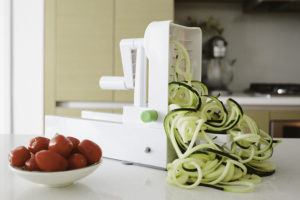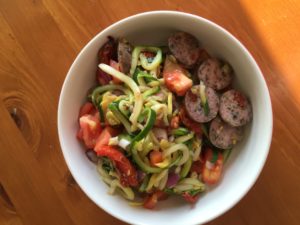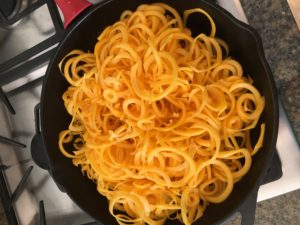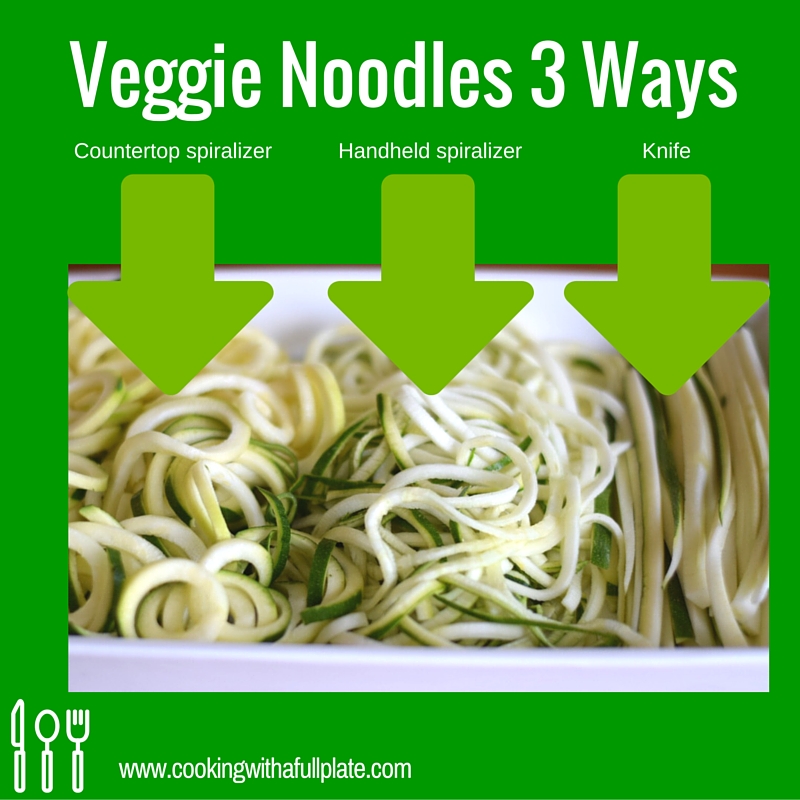I know, your house is already overflowing with crap. There’s the baby stuff that you aren’t quite ready to get rid of yet. The high school keepsakes that your parents sent your way when you bought your first home. The piles and piles of important paper in which you couldn’t find what you needed anyways. Not that I know about any of that ?
You don’t need one more thing, especially a thing that you won’t actually use. I get it.
That said, I do think that there are some tools that are worth investing in when what they take up in space is counterbalanced in what you save in time and create in quality. Things that come to mind in my kitchen? The high-end blender. The food processor. The electric water kettle. And my spiralizer.

Don’t get me wrong, you can absolutely cook healthy delicious food without a spiralizer – and I’ll show you an example of how below – but if pasta is your jam and you’re trying to eat more veggies, I promise that this little device will get enough use to justify both the price and the space it takes up.
And while I selfishly love that this baby makes low-cal noodles that are fun to eat for me, I’m even more enamored by the fact that my kiddo loves them too. Veggies that a kid is happy to eat? Worth every penny.
What the Heck is a Spiralizer?
According to Ali Maffucci, queen of spiralizing via her blog Inspiralized, spiralizing is the “art of turning veggies and fruits into noodles”.
A spiralizer is the tool that you use to transform said veggies and fruits. It’s basically a series of small blades and when you turn your food against them they create long thin strips resembling noodles.
When you’re done, they’ll look a lot like this:

Or this:

How to Choose the Right Spiralizer
Spiralizers being popular as they are currently, there are tons of choices out there. First, you’ll have to decide how much you want to spend and how much space you have:
- Spend a little and take up little space: a handheld spiralizer like this, this or this might be perfect for you
- Spend more and take up more space: countertop spiralizers like this, this or this (the one recommended by Sweethome) might be great options. Lindsay at Pinch of Yum has some great shots and details on different spiralizers on her site Pinch of Yum.
Full disclosure, I have the Inspiralizer by aforementioned Ali Maffucci, which I bought with my own money and I LOVE it. It’s easy to use, there are no loose pieces to be misplaced. And it’s super sharp and easy to clean, as long as you scrub it right away. The handheld spiralizer that I use in the video below is not in fact a Vegetti as I stated, but a 00
If you’re just getting started with trying out spiralizing, I’d suggest starting small and cheap and if you find that it’s something you’d like to do more of then upgrading to the bigger and pricier ones. I will tell you, there is a big difference between a handheld one and a countertop model – mainly in that:
- You have more options for noodle shapes
- You can get more out of the produce that you’re using (less waste)
- They’re a little bit easier to clean (in my experience)
- They can handle a wider variety of produce
- They’re faster
How To Make Veggie Noodles Without a Spiralizer
We used to live in a 700 square foot house with a galley style kitchen. I get it that sometimes there just isn’t anymore space, regardless of how useful or desirable something might be.
Never fear! You can actually create a similar “produce noodle” effect without a spiralizer. It won’t be exactly the same, and it works only with already long ingredients (since you don’t get the turning effect of a tool), but all you’ll need is a cutting board and a sharp knife.
I made a video of the three different techniques I talk about here in action, but if you just want to check out how to make veggie noodles with a knife and cutting board, skip to the 4:05 mark.
Basically the technique is to take a long, cylindrical vegetable (think: zucchini, carrot, parsnip, neck of a butternut squash) and:
- Slice along the length to create long, thin planks (about 1/4 inch thick)
- Take those planks and lay them flat, then cut in long, thin strips. The thickness you cut will determine the shape of your noodles
Here’s a comparison of the shapes/results you’ll get from different zoodle (the term the cool kids use for zucchini noodles) techniques:

Another alternative would be to use a julienne peeler like Angela from Oh She Glows does. It certainly takes up a lot less space and is easy to store!
What to Use your Spiralizer On
Ok, so you’ve decided to get a spiralizer. Or maybe you want to see more evidence of what you could make before making a decision.
Here are some examples from around the inter webs of what folks are making into noodles:
- Fooducate has a great list of veggies that you can spiralize – including broccoli stems, a personal favorite
- This Buzzfeed roundup of veggie noodles to make
- The Pinch of Yum post also have some great pictures of different produce spiralized and tips for doing it
Want to see more? Check back in later this week for a full recipe round-up and a video of a 15-minute meal I made with the help of my spiralizer.
This post contains affiliate links. As an Amazon Associate I earn from qualifying purchases.